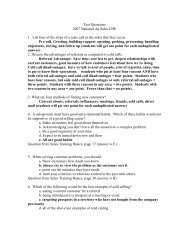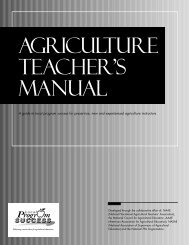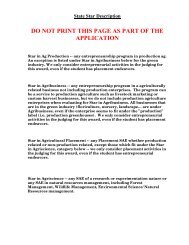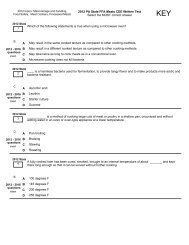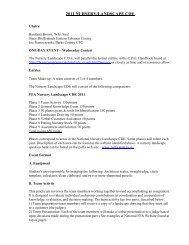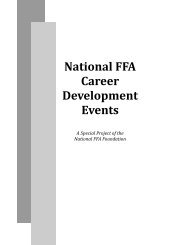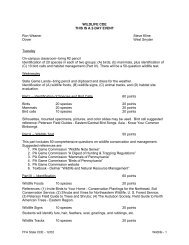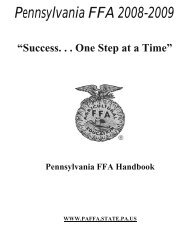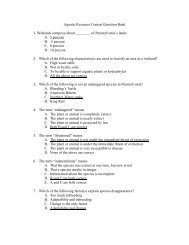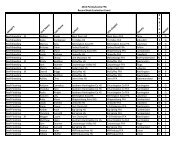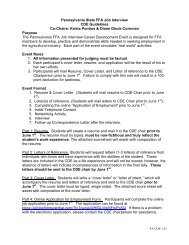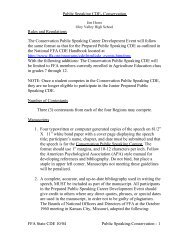2012 NATIONAL Farm Business Management CDE - Pa FFA
2012 NATIONAL Farm Business Management CDE - Pa FFA
2012 NATIONAL Farm Business Management CDE - Pa FFA
You also want an ePaper? Increase the reach of your titles
YUMPU automatically turns print PDFs into web optimized ePapers that Google loves.
<strong>Farm</strong> <strong>Business</strong> <strong>Management</strong> Career Development Event <strong>2012</strong>-2016National <strong>FFA</strong> <strong>Farm</strong> <strong>Business</strong> <strong>Management</strong> CareerDevelopment EventA Special Project of the National <strong>FFA</strong> FoundationImportant NotePlease thoroughly read the Introduction Section at the beginning of this handbook for complete rules andprocedures that are relevant to all National <strong>FFA</strong> Career Development Events.I. PurposeThe National <strong>FFA</strong> <strong>Farm</strong> <strong>Business</strong> <strong>Management</strong> Career Development Event provides competitionthat fosters information assimilation, critical thinking and problem-solving skills necessaryfor successful business management. The skills learned in this event can be used to successfullymanage a farm, pursue agricultural business careers and can be applied to personal financialmanagement. The National <strong>FFA</strong> <strong>Farm</strong> <strong>Business</strong> <strong>Management</strong> Career Development Eventenhances and encourages opportunities for all participants to receive instruction that developsbusiness management skills.For details about the scope of farms included in this event, see “What is a <strong>Farm</strong>?” in theResources section of this chapter.II. ObjectivesThe event objectives are for participants to demonstrate their ability to:A. Analyze business management information.B. Apply economic principles and concepts of business management to the decision-makingprocess.C. Evaluate business management decisions.D. Work together cooperatively as a group.III. Agriculture, Food and Natural Resources (AFNR) Career Cluster Content StandardsWith the recommendation of the National <strong>FFA</strong> Board of Directors, all national <strong>FFA</strong> programshave incorporated these standards to guide the direction and content of program materials andactivities. Refer to Appendix A in this chapter of the handbook for a complete list of the measurableactivities that participants will carry out in this event. For details about the incorporationof AFNR standards, refer to the Introduction chapter of the <strong>CDE</strong> handbook.IV. Principles and ConceptsThe principles and concepts listed below may be included in each section event.A. Economic Principles Related to <strong>Business</strong> <strong>Management</strong>1. Production functionsa. diminishing returnsb. profit maximizing point:i. MFC=MVPii. MC=MR2. Opportunity costsa. alternative investment opportunitiesb. alternative use of resources<strong>Farm</strong> <strong>Business</strong> <strong>Management</strong> Career Development Event 1
<strong>Farm</strong> <strong>Business</strong> <strong>Management</strong> Career Development Event <strong>2012</strong>-20163. Cost analysisa. fixed costsb. variable costs4. Input combinations5. Enterprise selectiona. equi-marginal returnsb. specialization and diversification6. Supply and demanda. price and quantity determinationb. elasticity of demandc. elasticity of supplyd. substitute, complementary and competitive productse. comparative advantage7. Types of marketsa. perfectly competitive marketsb. oligopoly marketsc. monopolistic competitionsd. monopoly marketsB. Concepts related to the use and analysis of records to manage resources1. Analysis of recordsa. financial statementsi. balance sheetii. income statementiii. statement of owner equityiv. statement of cash flowb. financial statement ratiosi. solvencyii. liquidityiii. profitabilityiv. repayment capacityv. financial efficiency2. Budgetinga. partial budgetsb. whole farm budgetsc. enterprise budgets3. Cash flow analysisa. summaryb. projections4. Managerial accounting5. Tax managementC. Concepts and functions of risk management1. Financiala. capital budgetingi. time value of moneyii. net present valueb. crediti. sourcesii. loan applicationsiii. interestiv. collateral<strong>Farm</strong> <strong>Business</strong> <strong>Management</strong> Career Development Event 2
<strong>Farm</strong> <strong>Business</strong> <strong>Management</strong> Career Development Event <strong>2012</strong>-2016c. leasing of real propertyd. land acquisition and ownershipe. machinery managementf. insurancei. life insuranceii. property insuranceiii. crop insuranceiv. health insurancev. liability insurance2. Marketinga. functionsb. price methodsi. cash marketsii. futures and optionsiii. contractingc. tradei. domesticii. international3. Legala. estate planningb. business organizationi. sole proprietorshipii. cooperativesiii. corporationsiv. partnershipv. limited liability company or partnershipc. written agreements4. Productiona. government programs and regulationsb. weatherc. disease5. Human resourcesa. training programsb. hiring employeesc. employee policies and proceduresd. compensation and benefitsD. <strong>Business</strong> <strong>Management</strong>1. Strategic managementa. vision statementb. mission statementc. goals2. Tactical planning3. Operational planning4. Succession planning<strong>Farm</strong> <strong>Business</strong> <strong>Management</strong> Career Development Event 3
<strong>Farm</strong> <strong>Business</strong> <strong>Management</strong> Career Development Event <strong>2012</strong>-2016V. Event RulesA. Team make-up- A team consists of three or four members. A team score consists of the totalof the top three individuals’ scores on the written exam plus the team activity score (allcertified members must participate in the team activity).B. It is highly recommended that participants wear <strong>FFA</strong> Official Dress for this event.C. Copies of the complete event with answers are distributed to all who are present at the eventevaluation meeting.VI. Event FormatA. Equipment Provided:1. Two sharpened No. 2 pencils.2. Non-programmable calculator – participants will not be allowed to provide their own.B. Team ActivityThe team activity evaluates the ability of team members to work together to use decisionmakingand problem analysis skills while applying economic principles and concepts taught inbusiness management.1. Members of a team work together cooperatively to complete this section.2. Ninety (90) minutes are allowed for completion of the team activity. At the end of theactivity, each team submits a written report to be scored.3. The team activity involves the use of business management skills and the resourceinformation.4. The team activity focus may include but is not limited to the following:a. An outgrowth of the current resource information and/or problems.b. Topics in the outline under the principles and concepts.c. Information in the most current <strong>Farm</strong> and Ranch <strong>Business</strong> Managemen textpublished by John Deere Publishing.5. The team activity has a maximum value of 300 points per team and is only included inthe team score. Points are divided as follows:a. Team Evaluation – 100 points- During the team activity section, the team isobserved by event judges and is evaluated on the team’s ability to work cooperativelyas a group.b. Team written answer sheet – 200 points6. All team members must be involved in the team activity to receive credit. If a team hastwo or less participants no credit will be allowed in the team portion of the event.C. Individual ActivityThe written exam tests the ability of the participants to use decision-making and problem analysisskills while applying economic principles and concepts taught in business management.1. Each team member works independently to complete the written exam. Each teammember receives an individual score on the written exam.2. Three hours are allowed for completion of the written exam.3. The written exam may include any type of question (such as multiple choice, shortanswer and fill-in-the-blank).4. All topics in the outline under the “Principles and Concepts” section can be included inthe written exam. <strong>Business</strong> management forms and procedures follow the samples andprocedures as presented in the most current <strong>Farm</strong> and Ranch <strong>Business</strong> Managemen textpublished by John Deere Publishing.5. The written exam has a maximum value of 300 points per team member.6. Individual scores on the written exam are used to calculate both the individual and teamscore.<strong>Farm</strong> <strong>Business</strong> <strong>Management</strong> Career Development Event 4
<strong>Farm</strong> <strong>Business</strong> <strong>Management</strong> Career Development Event <strong>2012</strong>-2016VII. Event ScoringThe following table summarizes the breakdown of points, event section for each pointallocation and the amount of time allowed for each section of the event.POINTSSection Time Individual TeamWritten Exam 180 Minutes 300 900Team Activity 90 Minutes 300Total 300 1200VIII. TiebreakersA. Judges will break ties on team scores using the following sequence:1. The score on the written section of the team activity.2. The score on pre-selected sections of the written exam.B. Judges will break ties on individual scores using the following sequence:1. The score on pre-selected sections of the written exam.IX. AwardsAwards will be presented to individuals and/or teams based upon their rankings at the awardsceremony. Awards are sponsored by a cooperating industry sponsor(s) as a special project, and/or by the general fund of the National <strong>FFA</strong> Foundation.X. ReferencesThis list of references is not intended to be all-inclusive. Other sources may be utilized, andteachers are encouraged to make use of the best instructional materials available. The followinglist contains references that may prove helpful during event preparation.Numerous sources of materials exist, and participating teams should consult with their state’scooperative extension service, the colleges and universities teaching farm and ranch businessmanagement and other material services available to the participating school. For the mostcurrent listing of resources and definitions for economic terms, refer to the national <strong>FFA</strong> website-farm business management <strong>CDE</strong> section at www.ffa.org.A. Primary:1. Jobes, Steward, Casey and Purcell (2004). <strong>Farm</strong> and Ranch <strong>Business</strong> <strong>Management</strong> (5thedition). Deere &Company, John Deere Publishing, East Moline, Illinois 61244. http://www.deere.com/publications2. Kay, Edwards and Duffy. <strong>Farm</strong> <strong>Management</strong>. McGraw-Hill Book Co., New York, NY.(6 th edition, 2008)3. <strong>CDE</strong> NCQ, National <strong>FFA</strong> Core Catalog, Indianapolis, IN. http://shop.ffa.org/cde-qasc1413.aspx(Published annually following the <strong>CDE</strong>.) Good source for examples ofenterprise budgets and financial statements used in the <strong>CDE</strong>.B. Secondary:1. Boehlje and Eidman (1984). <strong>Farm</strong> <strong>Management</strong>. John Wiley and Sons, New York, NY.2. Bowers, Love and Kletke (1994). Machinery Replacement Strategies. Deere&Company, John Deere Publishing, East Moline, Illinois 61244.Deere &Company.http://www.deere.com3. Dicks, Michael (1998). Agricultural Policy and How it Affects You, Deere &Company,John Deere Publishing, East Moline, Illinois 61244.<strong>Farm</strong> <strong>Business</strong> <strong>Management</strong> Career Development Event 5
<strong>Farm</strong> <strong>Business</strong> <strong>Management</strong> Career Development Event <strong>2012</strong>-20164. Oltmans, Klinefleter, and Frey (2001) Agricultural Financial Reporting and Analysis.Doane Agricultural Services, St. Louis, MO.5. Purcell, Wayne D. (1995). Marketing Agricultural Commodities. Deere & Company,John Deere Publishing, East Moline, Illinois 61244.6. Wilson, Purcell, Burton, and Wahlberg (1994). Managing Livestock Production. Deere& Company, John Deere Publishing, East Moline, Illinois 61244.7. Wilson, Purcell, Burton, and Wahlberg (1994). Managing Agricultural Commodities.Deere & Company, John Deere Publishing, East Moline, Illinois 61244C. Technical References:1. <strong>Farm</strong>ers Tax Guide, published by the Department of the Treasury, Internal RevenueService, can be obtained from the IRS Forms Distribution center in your state or the IRSwebsite. http://www.irs.gov/publications/p225/index.html2. <strong>Farm</strong> Financial Standards Council, Financial Guidelines for Agriculture Producers,1998 http://www.ffsc.org/.3. Assorted educational materials are available on hedging, forward contracting, and commodityfutures trading from any of the following addresses.a. Chicago Mercantile Exchange, 30 South Wacker Drive, Chicago, Illinois 60604.http://www.cmegroup.comb. Kansas City Board of Trade, 4800 West Main Street, Kansas City, Missouri64112c. New York Cotton Exchange, New York Mercantile Exchange Building, OneNorth End Avenue, New York, NY 10282-1101d. New York Mercantile Exchange, Commodity Exchange Ctr., One North EndAvenue, New York, NY 10282-11014. Doane Agricultural Services, Vance Publishing Corp., 77 Westport Plaza, #250, St.Louis, MO 63416. Doane provides a variety of educational materials related to farmand ranch management.5. Cooperative Extension Service in your state. Contact your local extension agent foraccess to farm and ranch management educational materials.<strong>Farm</strong> <strong>Business</strong> <strong>Management</strong> Career Development Event 6
<strong>Farm</strong> <strong>Business</strong> <strong>Management</strong> Career Development Event <strong>2012</strong>-2016D. What is a <strong>Farm</strong>?A farm is an area of land, including various structures, devoted primarily to the practice ofproducing food, fiber and, increasingly, fuel. It is the basic production entity. A farm can be aholding of any size from a fraction of an acre to several thousand acres. For purposes of theCensus of Agriculture, the U.S. Department of Agriculture defines a farm as any place fromwhich $1,000 or more of agricultural products were produced and sold, or normally would havebeen sold, during the census year. Single individuals or family members, partners or corporationscan own and operate farms. Depending on the volume of business produced on the farm,the farm may provide either part-time or full-time employment for the owners.<strong>Farm</strong>s are often categorized by the enterprises produced. Diversified farms will include severaldifferent crop and livestock enterprises. Grain farms specialize in the production of grain andoften do not have any livestock production. A ranch is a farm specializing in the raising ofgrazing livestock such as cattle or sheep for meat or wool. <strong>Farm</strong>s specializing in the productionof tree fruits or nuts are orchards; a vineyard produces grapes. A stable is a farm principallyinvolved in the training of horses. Stud and breeding stock farms breed and produce otheranimals and livestock. Dairy farms focus on the production of milk. A vegetable or truck farmis a farm that grows vegetables but little or no grain. Additional specialty farms include fishfarms, which raise fish in captivity as a food source, and tree farms, which grow trees for salefor transplant, lumber or decorative use such as Christmas trees. <strong>Farm</strong>s are usually thought of asbeing located in rural areas, but they are also located in urban areas. Urban farms are focused oncultivating, processing and distributing food in, or around a village, town or city. Urban farmscan also be involved in animal husbandry, aquaculture, agro-forestry and horticulture.<strong>Farm</strong> <strong>Business</strong> <strong>Management</strong> Career Development Event 7
<strong>Farm</strong> <strong>Business</strong> <strong>Management</strong> Career Development Event <strong>2012</strong>-2016Team Activity Evaluation - Observers Score SheetCriteria: Name of Observer:All team members were involved and contributed to the activity in an organized manner.Team members demonstrated effective listening and oral communication skills in resolving issues related to the presented task(s).Team members demonstrated cooperation in negotiating possible solutions that were relevant to the activity as presented.Teamwork EvaluationQuestions1234LeadershipIdentifiedEffectivelistening & oralcommunicationDemonstratedcooperation<strong>Pa</strong>rticipated inthe teamLow MediumScoring Ranges TeamNo.High State1 2 3 45-6 points 7-8 points 9-10 points Points Points Points PointsLeadership not evident, nolisting completed.Leadership evident, listingincomplete.Clearly identifies andlists leaders.22-24 points 25-27 points 28-30 pointsNot listening to each other,talking over other teammember, 1 member dominating.Listening and communicationsoccurring, but 2-3members dominating.Clearly evident that allteam members are listeningand discussing issues.22-24 points 25-27 points 28-30 pointsTasks primarily completedby one member, other memberscontributing onlyslightly.Tasks primarily completedby 2-3 members, othermember(s) assist occasionally.Clearly all team memberscompleting tasks,sharing written and oralcomputations/solutions.22-24 points 25-27 points 28-30 points1-2 members form the primaryteam, other membersparticipate occasionallyearly, fade over time.Members are engaged &attentive, with 2-3 makingnotes, participationfades over time.Clearly all members areengaged, attentive andmaking notes for the fullterm of event.Total:<strong>Farm</strong> <strong>Business</strong> <strong>Management</strong> Career Development Event 8
<strong>Farm</strong> <strong>Business</strong> <strong>Management</strong> Career Development Event <strong>2012</strong>-2016Team Activity Evaluation Summary ScorecardNational <strong>FFA</strong> <strong>Farm</strong> <strong>Business</strong> <strong>Management</strong> <strong>CDE</strong>Instructions:<strong>Pa</strong>rticipants should complete the information on this side ofthe scorecard. Please print clearly.Team Number __________State ________________Team members:1. Name:__________________________Role:______________________________________2. Name:__________________________Role:______________________________________3. Name:__________________________Role:______________________________________4. Name:__________________________Role:______________________________________<strong>Farm</strong> <strong>Business</strong> <strong>Management</strong> Career Development Event 9
Team Activity Evaluation Summary ScorecardNational <strong>FFA</strong> <strong>Farm</strong> <strong>Business</strong> <strong>Management</strong> <strong>CDE</strong>A. Teamwork Evaluation(observations)Criteria:• All team members were involved and contributed to the activity in anorganized manner.• Team members demonstrated effective listening and oralcommunication skills in resolving issues related to the presented task(s).• Team members demonstrated cooperation in negotiating possiblesolutions that were relevant to the activity as presented.B. Team Activity Solution Evaluation(written answer sheet)Criteria:• Team demonstrated knowledge of farm business management principlesand concepts and summarized consensus in the team activity answersheet.Points Possible 200Points Possible1. Team leadership roles were identified and demonstrated 102. Team members demonstrated effective listening and 30oral communication skills in resolving issues relatedto the presented task(s)3. Team members demonstrated cooperation in negotiating 30possible solutions that were relevant to the activity as presented4. Each team member participated in the team activity and 30contributed to the results reached by the teamScore:(Maximum 200 points) BTotal 100Summary of Evaluator’s Scores:Points EarnedEvaluator:1. ________________________________________ ______2. ________________________________________ ______3. ________________________________________ ______4. ________________________________________ ______Total Score for Team ActivityA + B =Average Evaluator Score:(Maximum 100 points) B
<strong>Farm</strong> <strong>Business</strong> <strong>Management</strong> Career Development Event <strong>2012</strong>-2016Appendix A: AFNR Career Cluster Content StandardsPerformance Measurement LevelsEvent Activity RelatedAddressing Measurement AcademicStandardsABS.01.01. Performance Indicator: Apply principles of capitalism in the businessenvironment.ABS.01.01.01.b. Differentiate types of ownershipand outline the structure of AFNR businessesin a capitalistic economic system.exam, team activityABS.02.01. Performance Indicator: Compose and analyze a business plan foran enterprise.ABS.02.01.01.c. Prepare and critique AFNR exam, team activitybusiness plans.ABS.02.02. Performance Indicator: Read, interpret, evaluate and write a missionstatement to guide business goals, objectives and resource allocation.ABS.02.02.01.a. Read and interpret mission exam, team activitystatements.ABS.02.03. Performance Indicator: Apply appropriate management skills toorganize a business.ABS.02.03.02.a. Identify appropriate local,state, federal, international and industry regulationsfor AFNR businesses.exam, team activityABS.03.01. Performance Indicator: Prepare and maintain all files needed toaccomplish effective record keeping.ABS.03.01.01.c. Apply management informationsystems in AFNR business financialexam, team activityanalysis.Social Studies:7b and 7gLanguage Arts:3, 4, 5, 7 and 8Social Studies:7hLanguage Arts:3, 4, 5 and 6Language Arts:12Math: 5A and 6BLanguage Arts: 8ABS.03.02. Performance Indicator: Implement appropriate inventory managementpractices.Language Arts: 8ABS.03.02.01.a. Monitor inventory to maintainoptimal levels and calculate costs of carry-exam, team activitying input and output inventory.<strong>Farm</strong> <strong>Business</strong> <strong>Management</strong> Career Development Event 11
<strong>Farm</strong> <strong>Business</strong> <strong>Management</strong> Career Development Event <strong>2012</strong>-2016ABS.04.01. Performance Indicator: Use accounting fundamentals to accomplishdependable bookkeeping and fiscal management.ABS.04.01.02.c. Evaluate characteristics of examlines of credit, loan terms and alternatives insources of capital.ABS.04.01.03.b. Analyze reporting requirementsfor income, property and employmentexam, team activitytaxes associated with small AFNR businesses.ABS.05.01. Performance Indicator: Maintain and interpret financial information(income statements, balance sheets, inventory, purchase orders, accountsreceivable and cash-flow analyses) for businesses.ABS.05.01.01.c. Interpret financial informationfor an AFNR business to determineprofitability, net worth position, financial ratios,performance measures and ability to meetcash-flow requirements.ABS.05.01.02.b. Recognize how changes inprices of inputs and/or outputs influence thefinancial statements of an AFNR business.ABS.05.01.03.c. Conduct a breakeven analysisfor an AFNR business.ABS.05.01.04.c. Interpret and evaluate financialstatements, including income statements,exam, team activityexam, team activityexam, team activityexam, team activityABS.06.01. Performance Indicator: Conduct appropriate market and marketingresearch.ABS.06.01.01.c. Implement and evaluate marketingstrategies with agricultural commodi-exam, team activityties, products and services.ABS.06.01.02.a. Describe functions in agriculturalmarketing.exam, team activityABS.06.03. Performance Indicator: Develop strategies for marketing plan implementation.ABS.06.03.01.b. Determine marketing strategiesthat are most likely to be effective in anexam, team activityAFNR business.ABS.07.03. Performance Indicator: Utilize appropriate techniques to determinethe most likely strengths, weaknesses and inconsistencies in a businessplan and relate these to risk management strategies.ABS.07.03.01.b. Describe approaches to usein revising a business plan for improved consistencyand realism.exam, team activityMath: 1C, 5Aand 5CSocial Studies:7hMath: 1C, 5Aand 5CLanguage Arts: 8Social Studies:7b and 7hSocial Studies:7b and 7hLanguage Arts:12<strong>Farm</strong> <strong>Business</strong> <strong>Management</strong> Career Development Event 12
<strong>Farm</strong> <strong>Business</strong> <strong>Management</strong> Career Development Event <strong>2012</strong>-2016ABS.07.04. Performance Indicator: Manage risk and uncertainty.ABS.07.04.01.b. Describe alternative approachesto reducing risk, including the use ofexam, team activityinsurance for product liability, property, productionor income loss and for personnel lifeand health.CS.01.01. Performance Indicator: Action: Exhibit the skills and competenciesneeded to achieve a desired result.CS.01.01.01.c. Work independently and in team activitygroup settings to accomplish a task.CS.01.01.03.a. Exhibit good planning skills team activityfor a specific task or situation.CS.01.01.06.b. Assign project parts equitably team activityamongst team members to achieve a giventask.CS.01.02. Performance Indicator: Relationships: Build a constituency throughlistening, coaching, understanding and appreciating others.CS.01.02.02.b. Utilize communication skills to team activitycollaborate in a group setting.CS.01.03. Performance Indicator: Vision: Establish a clear image of what thefuture should look like.CS.01.03.04.b. Demonstrate consensus building.team activityCS.01.06. Performance Indicator: Continuous Improvement: Pursue learningand growth opportunities related to professional and personal aspirations.CS.01.06.03.b. Utilize a problem-solving modelto solve a given problem.team activityCS.02.04. Performance Indicator: Mental Growth: Demonstrate the effectiveapplication of reasoning, thinking and coping skills.CS.02.04.01.c. Demonstrate critical and creativethinking skills while completing a task.CS.02.04.02.c. Implement effective problemsolving strategies.CS.02.04.03.c. Demonstrate the skills neededto negotiate with others.team activityteam activityteam activityLanguage Arts:12Social Studies:4d and 4hLanguage Arts:12Social Studies:4hSocial Studies:4a, 4d and 4hScience: A4Language Arts: 8Social Studies:4hMath: 6CScience: A4Language Arts: 4and 8<strong>Farm</strong> <strong>Business</strong> <strong>Management</strong> Career Development Event 13
<strong>Farm</strong> <strong>Business</strong> <strong>Management</strong> Career Development Event <strong>2012</strong>-2016CS.03.02. Performance Indicator: Decision Making –Analyze situations andexecute an appropriate course of action.CS.03.02.01.c. Make decisions for a given situationby applying the decision-making proteamactivityScience: A1, A5Social Studies:1c and 4hCS.03.02.02.c. Use problem-solving skills.team activity<strong>Farm</strong> <strong>Business</strong> <strong>Management</strong> Career Development Event 14
<strong>Farm</strong> <strong>Business</strong> <strong>Management</strong> Career Development Event <strong>2012</strong>-2016Appendix B: Related Academic StandardsNational academic standards for mathematics, science, English language arts and social studiesrelated to this event are reported below. The statements are based on information in reports ofthe respective associations/organizations in the academic areas. Some adjustment of numberingwas done to facilitate the process of alignment with the standards that have been developed inthe pathways of the Agriculture, Food and Natural Resources (AFNR) Career Cluster.The approach was to determine the presence of alignment between the content standards,expectations or thematic strands of the four academic areas and the performance indicators ofthe AFNR Standards. Supporting statements have been included to clarify content of therespective content standards, expectations or thematic strands. The statements were initiallydeveloped independently by the respective organizations and, therefore, are not parallel inwording and presentation. Occasionally minor editing was done to adjust the background orstem of a statement but not the statement itself.Mathematics1. Standard and Expectations: Number and Operations1C. Compute fluently and make reasonable estimates.5. Standard and Expectations: Data Analysis and Probability5A. Formulate questions that can be addressed with data and collect, organize and displayrelevant data to answer them.5C. Develop and evaluate inferences and predictions that are based on data.6. Standard and Expectations: Problem Solving6B. Solve problems that arise in mathematics in other contexts.6C. Apply and adapt a variety of appropriate strategies to solve problems.ScienceA. Content Standard: Science as an InquiryA1. Identify questions and concepts that guide scientific investigation.A4. Formulate and revise scientific explanations and models using logic and evidence.A5. Recognize and analyze alternative explanations and models.English Language Arts3. Students apply a wide range of strategies to comprehend, interpret, evaluate and appreciatetexts. They draw on their prior experience, their interactions with other readers and writers,their knowledge of word meaning and of other texts, their word identification strategies andtheir understanding of textual features (e.g., sound-letter correspondence, sentence structure,context, graphics).4. Students adjust their use of spoken, written and visual language (e.g., conventions, style,vocabulary) to communicate effectively with a variety of audiences and for differentpurposes.5. Students employ a wide range of strategies as they write and use different writing processelements appropriately to communicate with different audiences for a variety of purposes.6. Students apply knowledge of language structure, language conventions (e.g., spelling andpunctuation), media techniques, figurative language and genre to create, critique and discussprint and non-print texts.7. Students conduct research on issues and interests by generating ideas and questions, and byposing problems. They gather, evaluate and synthesize data from a variety of sources (e.g.,print and non-print texts, artifacts, people) to communicate their discoveries in ways thatsuit their purpose and audience.<strong>Farm</strong> <strong>Business</strong> <strong>Management</strong> Career Development Event 15
<strong>Farm</strong> <strong>Business</strong> <strong>Management</strong> Career Development Event <strong>2012</strong>-20168. Students use a variety of technological and information resources (e.g., libraries, databases,computer networks, video) to gather and synthesize information and to create and communicateknowledge.12. Students use spoken, written, and visual language to accomplish their own purposes (e.g.,for learning, enjoyment, persuasion and the exchange of information).Social Studies1. Thematic Strand: Culture1c. apply an understanding of culture and an integrated whole that explains the functionsand interactions of language, literature, the arts, traditions, beliefs and values and behaviorpatterns;4. Thematic Strand: Individual Development and Identity4a. articulate personal connections to time, place and social/cultural systems;4d. apply concepts, methods and theories about the study of human growth and development,such as physical endowment, learning, motivation, behavior, perception andpersonality;4h. work independently and cooperatively within groups and institutions to accomplishgoals;7. Thematic Strand: Production, Distribution and Consumption7b. analyze the role that supply and demand, prices, incentives and profits play indetermining what is produced and distributed in a competitive market system;7f. compare how values and beliefs influence economic decisions in different societies;7g. compare basic economic systems according to how rules and procedures deal withdemand, supply, prices, the role of government, banks, labor and labor unions, savingsand investments and capital;7h. apply economic concepts and reasoning when evaluating historical and contemporarysocial developments and issues;<strong>Farm</strong> <strong>Business</strong> <strong>Management</strong> Career Development Event 16



